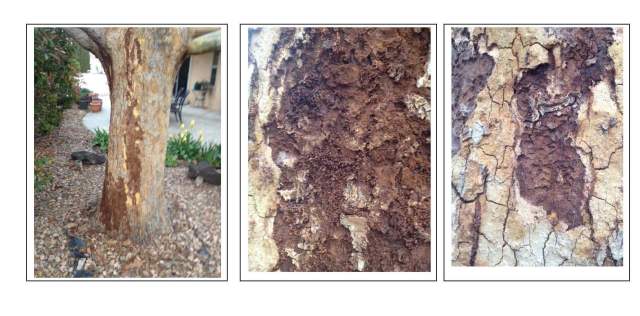Question
 Sycamore 3 images
Sycamore 3 images
We live in central NM and have a mature (25yr, +/-35') Sycamore in an irrigated part of our yard. Last year it went through a period of bark shedding, most of the branches now a light green or tan. The main trunk is shedding this year and is exposing areas with what appears to be dark brown frass, especially evident where bark is freshly shed. There are also some places with silk-like balls, almost like spider egg balls, but are empty. Our region has pine bark beetles, is there an equivalent that attacks sycamores? If it is can anything be done to save the tree? I would estimate about 10% of the trunk shows this symptom.
AnswerThis looks like sycamore Borer. Not a beetle but a clearwing moth. Sycamore borer (Synanthedon resplendens) larvae feed beneath the bark. They bore through the bark and produce galleries which sometimes destroy the plant抯 food and water conducting tissue. They pupate near the bark surface and emerge as adults in late spring to early summer.
揗ost mature trees can tolerate feeding by a few borers. When populations are high, feeding by larvae of certain species causes girdling and dieback of plant parts so that limbs may drop and entire plants may die. The presence of clearwing moths often indicate that trees lack appropriate cultural care or have otherwise been injured.?(UC IPM 2004)
Heavily colonized trees have a distinct bark checking appearance and may need immediate care.
IPM management consists of monitoring for boring frass and other pest activity, trunk drench treatments using an appropriate insecticide if/when necessary, and growing environment assessment and modification for stress reduction.
Non chemical method of control is physical probing of tunnels with a small wire to puncture and kill larvae or spraying appropriate species of nematodes into tunnel openings.
I would try an insecticide called Merit or Onyx. these are sprayed on the trunk where the damage is located and will soak in to the bark and kill the insect under the bark. Also to will protect other moths from attacking. I would also fertilize the tree with 10-10-10 fertilizer at the rate of 1 lb per inch of trunk diameter scattered around the tree and watered in good. Apply the fertilizer just before a rain storm and you will not need to water. Fertilize now and again late summer. This will increase the overall health of the tree and help prevent attack. Make sure the bark is kept free of wounds that can encourage moth attack. Check with your local garden/ nursery type store for these insecticides.






